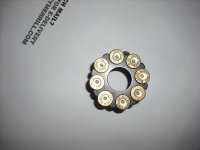LoboGunLeather
US Veteran
The individual firearm involved can have some effect. Even at moderate pressures it is possible for the primer to be forced to the rear early in the ignition/combustion cycle, then the cartridge case head is slammed back against the recoil shield (or slide breech face), reseating the primer in the primer pocket with the flattening effect.
The primer cup circumference being peened out into the radius-cut of the primer pocket entrance may support this theory. I can't detect it from the photos, but I suspect that the primer cup, around the firing pin indentation, may show markings from the milled surface of the revolver's recoil shield.
Obviously, firearms with greater clearances are more prone to this than those with closer clearances. Ammunition loaded for military use will usually have the primer crimped in place to reduce or prevent this from happening, particularly in automatic weapons firing from an open bolt (Browning MG, M60, Thompson, M3, and others).
The primer cup circumference being peened out into the radius-cut of the primer pocket entrance may support this theory. I can't detect it from the photos, but I suspect that the primer cup, around the firing pin indentation, may show markings from the milled surface of the revolver's recoil shield.
Obviously, firearms with greater clearances are more prone to this than those with closer clearances. Ammunition loaded for military use will usually have the primer crimped in place to reduce or prevent this from happening, particularly in automatic weapons firing from an open bolt (Browning MG, M60, Thompson, M3, and others).

